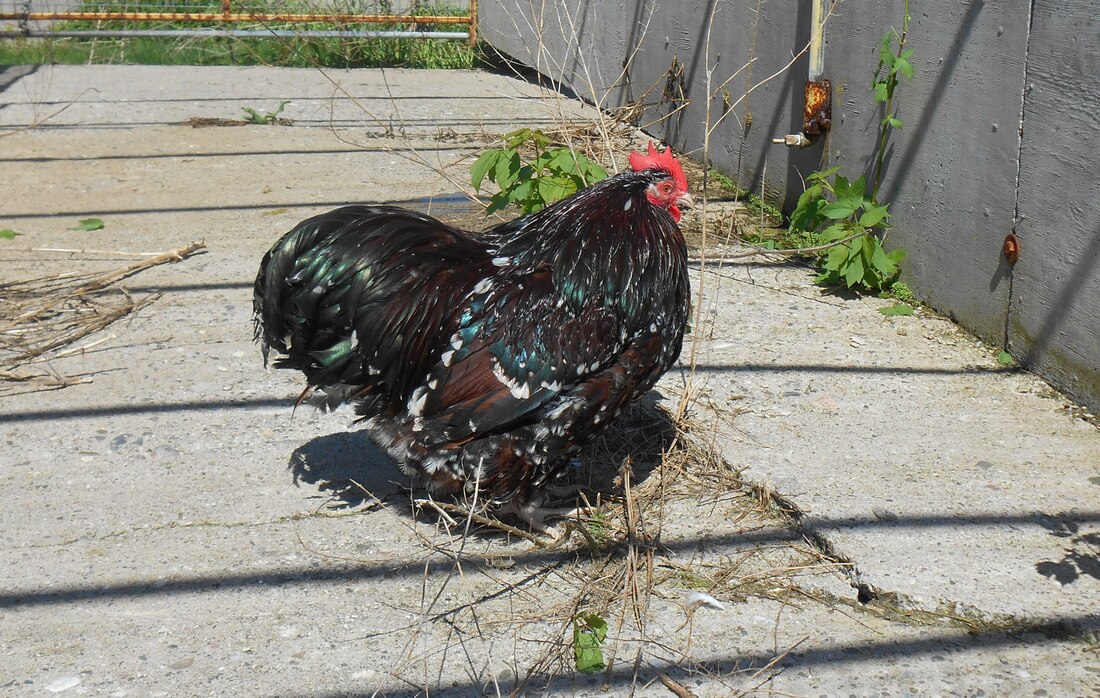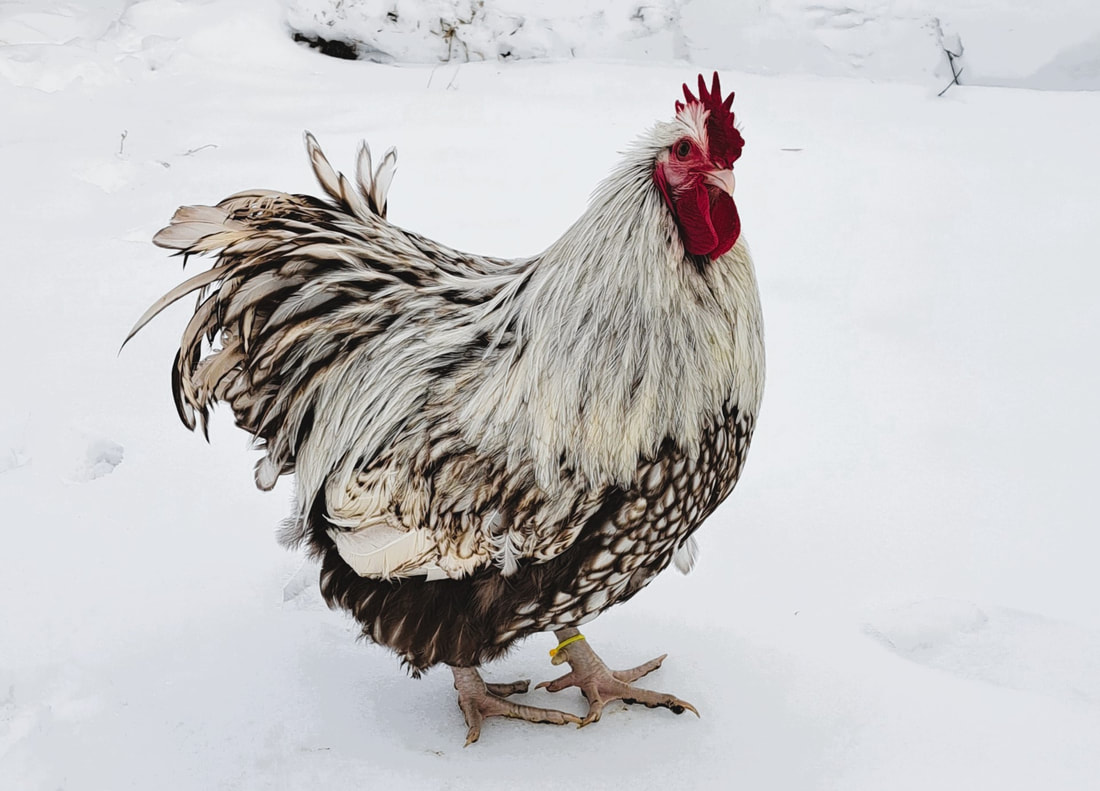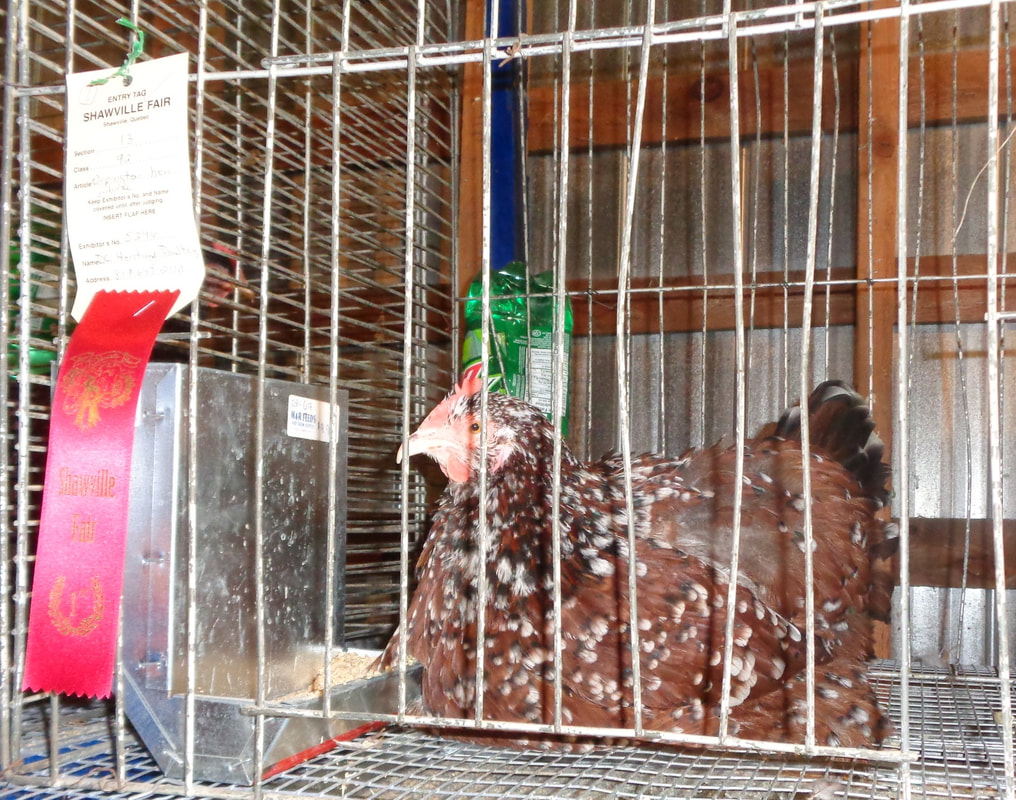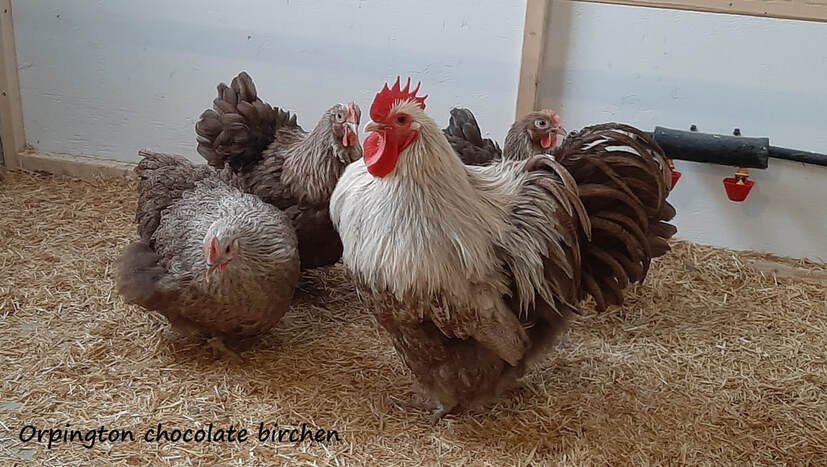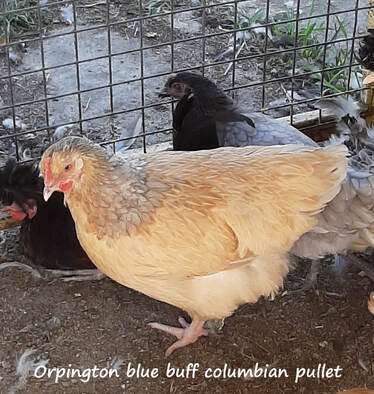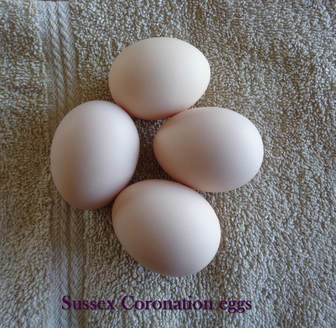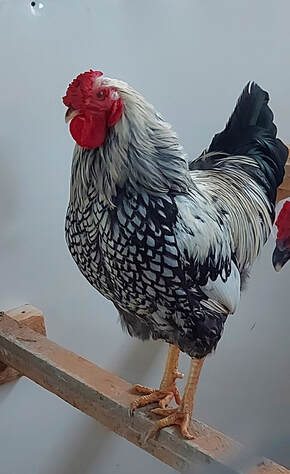Brahma

Description: There is controversy as to the origin of the Brahma chicken. While different claims were originally accepted as fact, the truth is that they were developed in America from large fowl imported from China by way of Shanghai and also the Chittagong fowl from India were used in the development and stamped head and comb characteristics termed beetle brow, onto the breed making it different from the Shanghai breed of chicken [ Cochin]. They have great size and vigor and were a principal meat breed from 1850-1930. Rooster getting up to 10lbs and hens 8lbs and chicks were harvested between 8-10 weeks old and virgin roosters were still considered tender for roasters at 13 mos. They were accepted into the APA in 1874 and the buff variety in 1924. Brahmas are extremely hardy and are good egg layers for their size. Laying a large medium brown egg, approx. 150 per year. Hens will go broody in early summer and lay most of their eggs from October to May considered a superior winter layer. They are a very quiet and clam breed bearing confinement well. They have feathered legs and feet and are considered a great choice for northern climates. They are often referred to as the ‘King of All Poultry” and make an excellent choice for the family fowl. Colors are: Light, Dark, Buff and new Silver-Laced.
We carry Buff & Blue Buff running together - Silver laced & Gold laced will be running together
Conservation List: Recovering
We carry Buff & Blue Buff running together - Silver laced & Gold laced will be running together
Conservation List: Recovering
Buckeye

The Buckeye chicken originated in the USA, in the state of Ohio [ Buckeye state]. Their color is Mahogany with black tail feathers and it is said to resemble the seeds of the Ohio Buckeye plant. The buckeye was developed in 1896 in Warren, Ohio by a woman named Nettie Metcalf and is the only American breed of chicken known to be developed by a woman. She wanted to create a dual-purpose breed that would do well in the bitter Midwest winters. They were admitted into the APA in 1904. Buckeyes are the only true American breed to have a pea comb. They tolerate confinement well but love to forage. They have decent laying ability approx. 200 brown eggs per year and have strong meat production characteristics. Buckeyes have yellow skin and legs. Roosters can weigh 9 lbs and hens 6.5 lbs. They are a generally calm but active breed and are noted for being good mousers. In addition, they are inquisitive and friendly but the odd rooster may become aggressive due to its game fowl background. Hens tend to go broody and retain their mothering ability and will raise their own young. The breed is vigorous, resilient and disease resistant and this breed does not get into feather picking even when crowded.
Conservation list: Threatened
Conservation list: Threatened
Cochin

Cochin’s are a large feathered legged chicken brought from Shanghai province, China as a gift for Queen Victoria in the1800’s and she adored them. Cochin’s were brought to the America’s in the 1840-1850’s. They were called Cochin-China. Cochins were recognized by the APA in 1874. They have sweet dispositions and are very calm. They are a very large breed of chicken and were designed for meat to have great table qualities at 12 weeks but excelled as a capon which would reach 12 lbs at 15-16 months of age. Roosters weigh approx 11lbs and hens 8.5 lbs. They tend to be more dark meat than white. They make excellent birds for children and rooters get along well together and are not quarrelsome and tend not to be aggressive towards people. They bear confinement well if allowed outside they don’t tend to wander or scratch profusely. A two-foot-high fence is enough to keep them in. Because they don’t fly rousts must be low to the ground. Hens lay approx 160 medium light brown eggs and they lay well in the winter. They are one of the best broody fowl and sometimes even the roosters will brood the chicks. They are great for hatching ducklings and turkey poults but can break thin shelled chicken eggs because of their size. They are very hardy and are great for making a home even in adverse conditions, great for extremely cold climates. They are reared principally now for exhibition. If you only have a few chickens, then a Cochin is a must. Cochins are mostly ornamental now.
Recognized variety of colors: Black, Buff, Partridge, White, Barred, Brown-Red, Red, Blue, Gold-laced, Silver-laced, Mottled, Columbian and Birchen.
We carry: Silver-laced and gold laced running together- SOLD OUT
Mottled & lavender mottled running together.
Conservation Status: Recovering
Recognized variety of colors: Black, Buff, Partridge, White, Barred, Brown-Red, Red, Blue, Gold-laced, Silver-laced, Mottled, Columbian and Birchen.
We carry: Silver-laced and gold laced running together- SOLD OUT
Mottled & lavender mottled running together.
Conservation Status: Recovering
Cornish

Cornish, first known as the Indian Game was developed in the southwest part of England in the county of Cornwall around 1820 by Sir Walter Raleigh Gilbert. He produced the breeds by crossing Red Aseel with Black Breasted Red Game of the Lord Derby type. They were recognized by the APA in 1893 as Indian Game in the Dark variety. In 1905 the APA changed the name to Cornish Indian game and White Indian Game, the white variety recognized in 1898. Early breeders of the breed in America didn’t like the name “Game” as it associated the breed with cockfighting which did not fit the breeds character and was holding back their popularity. In 1910 the APA renamed the bred Cornish and moved it from Oriental to English class of fowl. First, the muscular statue and strong appearance has intrigued many breeders for decades. Because they grew slowly and ate quite a bit, breeders faced the challenge of bringing the breed to market successfully. They found that due to the muscular body the young could be harvested early to produce small, tender, flavorful and meaty one-pound bird, the now well know “Cornish Game Hen”. Second way was to change the commercial poultry industry by crossing White Cornish with American breeds “White Phymouth Rock” ect, they could produce extremely fast growing market poultry. Today the cross can be harvested at 6-8 weeks. Facts about the breed are they are gentle and calm, used for meat with roosters weighing 8.5 lbs [some have reached 15 lbs] and hens 6.5 lbs. They have a red pea comb and thick stout yellow legs and skin. Hens and rooters look almost identical. Feathers are short with not much down, considered “Hard Feathered” winter hardy but need to be kept out of drafts. Hens lay a medium tinted egg and have a production of moderate to good and will go broody and be very protective of their chicks. They bear confinement well but do enjoy some outdoor exercise. Recognized color’s: Dark 1893, White 1898, White-Laced Red 1909, and Buff 1938. Black has not been recognized. We carry Standard Fowl in: White, Dark and White-Laced Red
Conservation Status: Watch
Conservation Status: Watch
Cubalaya

The Cubalaya is a Cuban breed of domestic chicken. It is the only chicken breed with the official recognition from the Asociacion National de Avicultura, the Cuban national poultry association. They are a dual purpose breed for meat and eggs. Sometimes referred as a Trifecta chicken in Cuban because they were also used for cock fighter, hence a breed for meat, eggs and game. They were first introduced into the U.S.A. in 1939. They were developed form game fowl brought from the Phillipines, mainly Sumatra’s and Malay’s and crossed with native fowl creating the Cubalaya. One distinct trait is the lack of spurs, which was favored during the breed’s development, so the young bird don’t hurt each other when starting to struggle for dominance within the flock. They are less likely to fight in a flock situation than other game birds, in fact they are really on the mild side. The primary breed characteristic is the lobster tail. They come in many different colors. They are striking breed, active and winter hardy with a small bright red pea-comb, which doesn’t get frost bitten. Cubalaya’s are known for producers of quality meat and reliable layers of medium sized tinted eggs. Roosters weigh approx 6 lbs and hens 4 lbs. The hens do go broody and are good mom’s. The breed tolerant confinement but are also good foragers. The trait most favored with the breed is its tameness towards people. They are very friendly. The roosters can be aggressive to other roosters but never to people. In Cuba the Cubalaya is still used commercially for meat and eggs but they are still on the threatened list. Colors include White, Black, Black Breasted Red, Red Pyle and Blue Breasted Red.
We carry: Black Breasted Red
Conservation Status: Threatened
We carry: Black Breasted Red
Conservation Status: Threatened
Delaware

The Delaware breed which use to be called “ Indian Rivers” originated in the State of Delaware, USA and developed by George Ellis in the 1940’s. It is a relatively new breed to chicken. Delaware’s were once very important to the U.S. chicken broiler industry. Delaware hens mated to New Hampshire roo’s or Rhode Island Red roo’s produce a sex-link chicks with male chicks having the Delaware pattern and the female chicks red like their fathers. Though their economic dominance was short lived Delaware’s still make an excellent dual-purpose bird. The breed is noted for fast growth and fast feathering chicks with a calm and friendly disposition. They are hardy & mature early, laying a large brown egg, and will go broody and make good mom’s. Roo’s weigh 8 lbs and hens 6 lbs. Delaware’s perform well in the cold but roo’s comb’s may freeze. They can adapt to confinement or free range. The bird is white with barring on its neck and tail.
Conservation status: Watch list
Conservation status: Watch list
Dorking

.Dorking chickens are a five-toed dual purpose bird and are one of the most ancient breeds of all domestic poultry. Believed to have originated in Italy where it was developed during the Roman Empire. Romans loved the five toed fowl for their fine table qualities. Oddly there are no five toed fowl developed in Italy today. They were taken as far as Britain when the Romans invaded as early as 55 BC. The breed was described by the Roman writer Columella in his treatise ‘Of Husbandry in Twelve Books”. They were developed as a landrace breed in the Southern part of England in the counties around Surrey, Kent and Essex. The areas around these counties were renowned for producing the highest quality table birds; the five toed Dorking having been the most sought after of these chickens. They were named after the town of Dorking, once called Darking. Exactly when Dorking arrived in the America’s is a bit of a mystery but they were well distributed by 1840. They were one of the breed that was shown at the first poultry show in 1849. They were recognized by the APA in 1874. Dorking hens are excellent winter layers except that after laying approx. 30-45 eggs they want to sit. They are great sitters and mothers and will often stay with the chicks longer than other breeds and will often welcome chicks from other hens. They will lay approx. 150 large white eggs per year. Pullets tend to be slow to lay, later than some other breeds. They don’t wander far from home and are good foragers. They have a heavy body with short legs roosters weighing 9 lbs and hens 7 lbs. They produce a very fine white meat. They are friendly quiet and calm. They can take up to 2 years to fully mature and can live as long as 7 years. They are very hardy and can tolerate all climates but care must be taken in very cold weather as the rooster large comb points may freeze. There are 5 standard colors and all colors have red eyes, combs, wattles, and earlobes with white legs and feet. Colors: Silver Grey, Dark, Red, Cuckoo and White
We carry: Silver Grey
Conservation status: Watched
We carry: Silver Grey
Conservation status: Watched
Euskal Oiloas (Basque chicken)

Description: Euskal Oiloa often referred as the Basque hen. They are a Spanish chicken found along the Cantabrian coast of Spain. Dual purpose and are extremely rare. They are fast growing. They lay approx 220 eggs a year. The hens rarely go broody and can start laying as early as 4 months. They have a good feed to egg and meat ratio. Good foragers, but do well in confinement. The roosters weigh up to 8 lbs and the hens 5 1/2 lbs. Good egg layer of big brown eggs. They are very friendly and a very nice chicken to add to the hen house. There are 5 varieties . We carry the marraduna (barred color).
Faverolle

This breed was developed in the 1860’s in the area of the village of Faverolles, located in the Eure-et-Loire region just southeast of Paris, France. Named after the village of Faverolles and the singular is still Faverolles not Faverolle as it is a French word and the last letter is not pronounced but the A.P.A. currently recognizes the official spelling as Faverolle without the ‘s’ and plural with the ‘s’. The breed was introduced into England in 1894 and then imported into the United States in 1901-1902 by Dr. A.H. Phelps of Glen Falls NY. In Europe the breed comes in many colors black, buff, cuckoo, laced blue, salmon and white, but in America only the Salmon and white varieties are recognized by the APA. Salmon is a unique color pattern found exclusively on the Faverolle chicken.They have 5 toes & a beard & muff. They are a dual purpose breed for eggs and meat with hens laying approx. 240 medium-large light brown, pinkish eggs with good winter laying ability. They are good sitters and mothers. They mature early and are very hardy. Roosters weigh approx. 8 lbs and hens 6.5 lbs. They are very gentile and calm and make good chickens, as they love to be cuddled and can become almost affectionate. During the 1900’s it was considered the best French breed developed so far producing fine boilers and roasters. We carry the Salmon and Blue Salmon running together.
Conservation status: Threatened
Conservation status: Threatened
Iowa Blue

The Iowa Blue is a breed of chicken that originated near Decorah Iowa in the early 1900’s. Despite the name the bird is not actually blue. The males are approx 8 lbs and hens are 7 lbs. Hens lay from 180-250 light brown eggs a year. The breed was rescued from near extinction in the late 80’s but is still a very endangered breed. With a good attitude and proud carriage, this breed is a good dual purpose homesteader chicken. It is known to be an excellent forager. Hens will go broody and have good material characteristics. The roosters are noted to be excellent flock guardians and are talented hawk fighters. They have even been known to take on raccoons and skunks, but they are not aggressive towards people. The breed is early to mature. Iowa Blues are fairly docile and not flighty. When mated with White Rock’s or New Hampshire’s, Iowa Blue’s will produce sex-linked chicks. The Iowa Blue breed club recognizes 4 colors at this time, Birchen, Silver, Smokey and Charcoal. We carry the Birchen, Silver, Smokey and Charcoal all running together.
Java

The Java is a large bird with a striking appearance. It is critically endangered old dual purpose breed. The Java is considered the second oldest breed of chicken developed in the U.S.A. after the Dominique. It’s ancestors come from Asian stock, possibly from the isle of Java. The Java is a good homesteading fowl having the ability to do well when given free range. The breed is calm, easy to handle and docile, even the roosters. Hens consistently lay a large brown egg and are good mothers. They also bear confinement well. Even though Java’s were once found though out the Eastern U.S.A their numbers have dipped so low some wonder if it’s possible to save them from extinction. The Java is a hardy breed even in inclement weather. Java’s are suitable for both meat and egg production on small farms and for backyard poultry keepers. They are good for meat but do grow slowly. Color varieties are: Black, Mottled, White, and Auburn.
We carry mottled and Auburn
Conservation status: Watched
We carry mottled and Auburn
Conservation status: Watched
Jersey Giant

Description: Jersey Giants were developed as a dual-purpose breed in the 870’s by John and Thomas Black, brothers from Jobstown in Burlington County, New Jersey, U.S.A. Breeds used in their development were Black Java, Black Langshan and Dark Brahma’s. The Black brothers intended on creating a chicken that would replace the turkey with roosters weighing 13 lbs and hens 10 lbs making them the largest purebred chicken breed. In 1885 they were called Black Giants in honor of their developers. The name was later changed to Jersey Giants by Dexter P. Upham of Belmar, New Jersey in honor of the State of origin. Upham was an early breeder of the Giants interested in improving them. In 1921, The American Association of Black Giant Breeders Club was created and the name Jersey Giant was officially adopted for the breed by the club. They were recognized by the APA in 1922. They did not make the commercial market because they grow slow putting on frame size before meat which may take 8-9 months with market weight being 8-11 lbs. They are excellent roasting birds when mature. The birds have a gigantic frame, single red comb, and yellow skin with Black birds having black legs and White birds have willow legs both with yellow bottom feet. They are gentle and calm and bear confinement well but are also good foragers. Hens lay approx 180 large eggs per year in shades from dark brown to light cream and some go broody. Jersey Giants hens tend to lay more eggs than other heavy breeds. When incubating their eggs, it may take 1-2 days longer to hatch the eggs. They are a strong robust breed and tolerate cold weather. They don’t fly so relatively low fences will keep them in. They are also very friendly with other chickens and don’t tend to fight. They are two recognized colors by the APA, Black and White but there is a blue color not yet recognized by the APA. We carry the White, Black and Blue all running together.
Conservation Status: Watch
Conservation Status: Watch
Langshan

Description : The Langshan is a rare endangered breed of chicken which originated in China around the Yangtzekiang river district approx 100 miles from Shanghai in the region of Langshan which means Wolf Mountain in Chinese. They are in the Asiatic class . Black Langshan’s were imported into England by Major Croad, his name has been linked to a particular variety of Langshan called “Croad Langshan”. In the U.K. there are two types of Langshans, the Croad and the German varieties. The German lacks feathering down the shanks and toes. The German variety has not been accepted into the APA. So most Langshans you see are Croad type. The Langshan is considered a dual-purpose breed. They are a good producer of very pretty brown eggs with tints to terracotta and some pinkish-purplish tones. Males can get quite tall with a very large tail that is held erect and obtains lengths up to 16 inches and is very impressive when fully developed. They have a very defined “U” shape to their backs. The breed is cold hardy. The single comb is red, wattles, earlobes are also red, leg’s are slate grey with pink soles. It is a heavy bird with males weighing 9 lbs and hens 7.5 lbs. The skin is white, breast is deep and full with abundance of white meat rich in flavor [ the white meat is particularly white in color] so they make and excellent table bird. They are a smart, strong adult bird and chicks are hardy, grow very well and pullets start to lay at 6-7 mos. Hens are excellent sitters and being a very large bird can cover 12 eggs easily and make wonderful attentive Mom’s. They are docile, quiet and tolerant birds which are friendly and easily tamed and are a great choice for kids and families. They bear confinement well. There is also a Bantam type. They come in Black with green beetling, white and blue with some breeders working on a barred variety.
We breed the large fowl and have Black, White and Blue running together
Conservation status: Watched
We breed the large fowl and have Black, White and Blue running together
Conservation status: Watched
New Hampshire

New Hampshire
New Hampshire chickens originated in the state of New Hampshire and Massachusetts USA. The honor of creating the breed goes to Professor ‘Red” Richardson who was working in one of the Agricultural Experimentation Station at the time. Around 1910 they were working on a separate strain of Rhode Island Reds, trying to develop a breed that would feather faster, grow fast an lay sooner and also be hardy in the bitterly cold winters of the north-eastern United States. They produced a reliable and robust hen that doesn’t disappoint when it comes to producing delicious eggs. The New Hampshire breed was born. The breed was admitted to the APA in 1935. It is a dual-purpose breed, selected for both meat and egg production. Medium heavy in weight, it dresses a plump yellow skinned carcass, as either a broiler or roaster. Mature males weigh 7.5 lbs and hens 6.5 lbs. They are a docile breed but can be competitive with other chickens. Generally easy to tame and a great family pet but some can become aggressive. Hens lay approx. 240 large brown eggs per year and can go broody and make great moms. They like to roost 2-4 feet off the ground. Do well in confinement or free run. The breed is nearer a chestnut shade with occasional pale yellow highlights, with neck and tail feathers tipped in black. They’re two other color varieties, the blue-tailed developed in Holland, remains quite rare and the New Hampshire White is also now quite rare and it is hard to find a good breeder of the lovely bird. When the breed was being developed there were a few sports with white and black feathers which were later developed into the Delaware. You can produce sex-linked chicks with crossing a New Hampshire rooster over Barred Rock hens, will give you a black sexlink chick or a New Hampshire rooster over a white Plymouth Rock or Rhode Island white hen will give you a red sexlink offspring. In 2018, a petition organized by the Canaan Elementary School was presented to the Governor of New Hampshire to make the New Hampshire the official bird of the state. The Governor signed it into law the same year. There is also a bantam variety.
Conservation status: Watch List
New Hampshire chickens originated in the state of New Hampshire and Massachusetts USA. The honor of creating the breed goes to Professor ‘Red” Richardson who was working in one of the Agricultural Experimentation Station at the time. Around 1910 they were working on a separate strain of Rhode Island Reds, trying to develop a breed that would feather faster, grow fast an lay sooner and also be hardy in the bitterly cold winters of the north-eastern United States. They produced a reliable and robust hen that doesn’t disappoint when it comes to producing delicious eggs. The New Hampshire breed was born. The breed was admitted to the APA in 1935. It is a dual-purpose breed, selected for both meat and egg production. Medium heavy in weight, it dresses a plump yellow skinned carcass, as either a broiler or roaster. Mature males weigh 7.5 lbs and hens 6.5 lbs. They are a docile breed but can be competitive with other chickens. Generally easy to tame and a great family pet but some can become aggressive. Hens lay approx. 240 large brown eggs per year and can go broody and make great moms. They like to roost 2-4 feet off the ground. Do well in confinement or free run. The breed is nearer a chestnut shade with occasional pale yellow highlights, with neck and tail feathers tipped in black. They’re two other color varieties, the blue-tailed developed in Holland, remains quite rare and the New Hampshire White is also now quite rare and it is hard to find a good breeder of the lovely bird. When the breed was being developed there were a few sports with white and black feathers which were later developed into the Delaware. You can produce sex-linked chicks with crossing a New Hampshire rooster over Barred Rock hens, will give you a black sexlink chick or a New Hampshire rooster over a white Plymouth Rock or Rhode Island white hen will give you a red sexlink offspring. In 2018, a petition organized by the Canaan Elementary School was presented to the Governor of New Hampshire to make the New Hampshire the official bird of the state. The Governor signed it into law the same year. There is also a bantam variety.
Conservation status: Watch List
Orpington

The Orpington is a British breed of chicken developed in the late nineteenth century by William Cook, a coachman living in the town of Orpington, in the county of Kent, in south east England. It was bred to be a dual purpose breed created to be reared for both meat and eggs, that was bigger and better than existing breeds of the time. Mr. Cook unveiled the Black Orpington in 1886. It was bred to be black to hide the dirt and soot that was prevalent in cities at that time. The breed became an overnight success story. The bird should be heavy, broad body, fluffed with smooth feathers and a short back. The eyes are reddish bay color, combs are red and come in single with 5 points or a rose comb, wattles red, feet and shanks are pinkish white and the skin is white. Males weigh approx. 10 lbs and hens 8 lbs and are table ready at 22 weeks. There is a bantam variety with males weighing 38 oz. and hens 34 oz. Hens start to lay at 5-6 month, laying 200-280 brown eggs per year and do go broody and make great Mom’s. They tolerant confinement but also love to free range. They are extremely docile especially the Buff’s, making a great choice for children as they don’t mind being handled. They are cold hardy but need a bit of shade in the summer. Recognized colors in the APA are Buff, Black, White and Blue. There are many more colors but they are not recognized. They are not on The Livestock Conservancy List anymore as they were taken off the endangered list in 2016.
We carry buff, lavender, jubilee ,Silver Laced, Chocolate Birchen, Blue/Buff Columbian, Chocolate mottled
NEW For 2024 chocolate silver laced
We carry buff, lavender, jubilee ,Silver Laced, Chocolate Birchen, Blue/Buff Columbian, Chocolate mottled
NEW For 2024 chocolate silver laced
Sussex
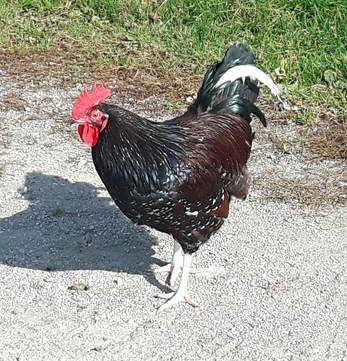
The history of the Sussex chicken breed is unclear. Some poultry historians believe the breed’s ancestors were the same as the Dorking’s and that Sussex history traces to the Roman occupation of Britain. What we know is that it was fully developed and present in the English counties of Sussex, Kent and Surry by the mid-1800’s. Sussex are one of the oldest chicken breeds still with us today in fair numbers. They were prized as a table fowl for more than 100 years as they fatten quickly. They arrived in the U.S. around 1912 then a couple years later in 1914 they were recognized by the APA. They are easy to handle, friendly, curious, active birds that will follow caretakers for a treat. They have close fitting feathers, a single red comb, earlobes and wattles with white skin, leg shanks and feet. Hens lay 250 tan to light brown large eggs per year and are good winter layers. Hens will go broody and make good Mom’s. Males weigh 9 lbs and hens 7 lbs. They are a good all around dual purpose breed famous for being a good table bird with great flavor. They do well in confinement but are also excellent foragers and are ideal for free range conditions. They come in a variety of color’s: red, buff, buff columbian, speckled, light, white, silver, coronation and brown [ a very dark red ]. We carry speckled and coronation.
Status: Recovering
Status: Recovering
Wyandotte

The Wyandotte is an American breed developed in parts of upstate New York and Ontario, Canada in the 1870’s. They were first called American Sebrights as the first color developed was the silver laced variety but this was later changed to Wyandotte after the native American tribe called Wyandat but they have no historical association to the tribe. The Wyandotte is an excellent dual purpose breed that matures very quickly. They are good layers of approx. 200 large brown eggs per year and lay though the winter. Hens have strong broody tendencies and make great mothers. They are a large chicken with roosters weighing 8.5 lbs and hens 6.5 lbs and are still considered a great table bird. They have a rose comb with face, earlobes and wattle’s a bright red color. The breed is hardy and well suited to cold weather or summer temperatures. They are gentile and calm and do well in confinement and are also good foragers making them great for free ranging. They were admitted into the APA in 1883. They come in a variety of color’s: silver laced, gold laced, blue laced red, black, white, buff laced, partridge, silver penciled, Columbian, chocolate and lavender. . In 2016 the Livestock Conservancy’s priority list, considers them no longer endangered and are now considered as Recovering.
We carry silver laced, gold laced, blue laced
New for 2024 is lavender
We carry silver laced, gold laced, blue laced
New for 2024 is lavender
Vorweck
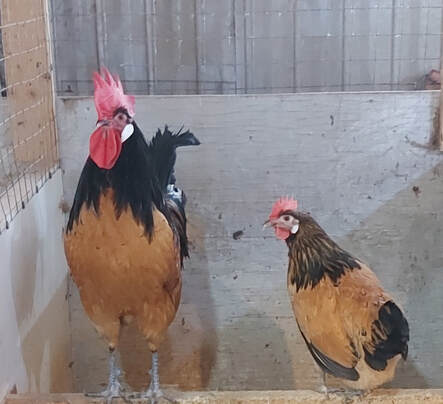
Vorweck’s were developed in Hamburg, Germany by Oskar Vorweck. In 1902 he set out to create a bird that was more useful than the Lakenvelder, replacing the white with buff so it would not show the dirt. They have red medium sized wattles and a straight comb with up to 6 points and white earlobes. They also have orange/red eyes and slate grey under fluff and slate blue legs with four toes. Plumage is soft and glossy. The Vorweck is a different breed but is very similar to the Lakenvelder but it has a bulkier type body with less tail. Creating a bird that would lay a good number of eggs with a good feed to egg ratio as well as meat for the table when required. Thus this chicken is sometimes incorrectly called the Golden Lakenvelder, especially in North America. By 1913 the breed was standardized and is rare outside Continental Europe. They are an attractive bird with a black head, hackles and tail feathers, the body and wings are buff. Vorweck's are alert and active generally docile and calm suitable for beginners. They have good foraging skills and a good choice for free range system but they also do well in confinement. Chicks are fast growers and mature quickly. They can fly reasonably well and are not broody . Hens lay 160-190 white/ cream tinted eggs. In Europe fanciers of this German breed independently created a bantam by selectively breeding down from the standard Vorweck, the most common way to create a miniature. In 1966 a U.S. man named Wilmar Vorweck of New Ulm, Minnesota, develop and interest in the breed, but it had not been exported to North America at that time. Thus he created a bantam version from scratch using Lakenvelder’s. So both versions of the Vorweck Bantam was not created the same. Both standard and bantam are considered dual-purpose chickens suitable for both meat and egg production. Standard males weigh 5.5-7.5 lbs and hens 4.5-5.5 lbs. Bantams males 27 oz and hens 23 oz. They are considered hardy in cold climates and will continue to lay throughout the winter. Roosters are gentle and are tolerant of each other and you can keep more than one rooster in the flock. The Standard German Vorweck and the European Vorweck Bantam were never admitted into the APA, though the US Bantam is recognized by the APA and the American Bantam Association. This is considered a very rare breed and it was almost lost after WWII. We carry the standard.








































